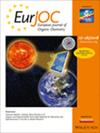Catalyst‐Free Depolymerization of Aromatic and Aliphatic Polyesters Using Me3SiI
IF 2.5
3区 化学
Q2 CHEMISTRY, ORGANIC
引用次数: 0
Abstract
Iodotrimethylsilane (Me3SiI) promotes the depolymerization of a variety of alkyl and aromatic polyesters, such as poly(ethylene succinate) (PES), polylactic acid (PLA) as well as polyethylene and polybutylene terephthalates (PET, PBT), in the absence of catalyst. The monomer products, e. g. the silylester monomers and/or their value‐added derivatives, involving reactive iodo groups (alkyl iodides and acyl iodides), are obtained in high yields. The reaction outcomes are influenced by the solvent (e. g. CH2Cl2, CH3CN), temperature (25 °C to 200 °C) and the amount of Me3SiI. The depolymerization of PES gives the corresponding silylester which then cyclizes into succinic anhydride. With PLA, the ester CH3CH2CO2SiMe3 and propionyl iodide (CH3CH2COI) are formed. They can be selectively obtained by adjusting the reaction conditions. As expected, the decomposition of aromatic polymers PET and PBT affords the bis(trimethylsilyl) terephthalate compound (1,4‐{CO2SiMe3}2C6H4). In the case of PET, the formation of the latter species is hampered by the I2, released by the decomposition of the generated diiodoethane. The initial addition of an iodine trap (1‐pentyne) avoids these side reactions. This work demonstrates that the length of the carbon chain linking the carboxylic acid units is a crucial factor influencing the ease of the reaction and the nature of the products.

Me3SiI无催化剂解聚芳香族和脂肪族聚酯
在没有催化剂的情况下,Me3SiI能促进一些烷基和芳香族聚酯的解聚。单体产品和/或其增值衍生物以高收率获得。反应结果受溶剂选择、温度和Me3SiI用量的影响。聚醚解聚得到丁二酸酐。聚乳酸形成了CH3CH2CO2SiMe3酯和碘化丙酯(CH3CH2COI)。通过调整反应条件,可以选择性地得到它们。芳香族聚合物PET和PBT的分解得到双(三甲基硅基)对苯二甲酸酯化合物(1,4-{CO2SiMe3}2C6H4)。对于PET,后者的形成受到释放的I2的阻碍。最初加入的碘阱(1-戊烷)避免了这些副反应。连接羧酸单元的碳骨架的长度影响反应的难易程度和产物的性质。
本文章由计算机程序翻译,如有差异,请以英文原文为准。
求助全文
约1分钟内获得全文
求助全文
来源期刊
CiteScore
5.40
自引率
3.60%
发文量
752
审稿时长
1 months
期刊介绍:
The European Journal of Organic Chemistry (2019 ISI Impact Factor 2.889) publishes Full Papers, Communications, and Minireviews from the entire spectrum of synthetic organic, bioorganic and physical-organic chemistry. It is published on behalf of Chemistry Europe, an association of 16 European chemical societies.
The following journals have been merged to form two leading journals, the European Journal of Organic Chemistry and the European Journal of Inorganic Chemistry:
Liebigs Annalen
Bulletin des Sociétés Chimiques Belges
Bulletin de la Société Chimique de France
Gazzetta Chimica Italiana
Recueil des Travaux Chimiques des Pays-Bas
Anales de Química
Chimika Chronika
Revista Portuguesa de Química
ACH—Models in Chemistry
Polish Journal of Chemistry.

 求助内容:
求助内容: 应助结果提醒方式:
应助结果提醒方式:


